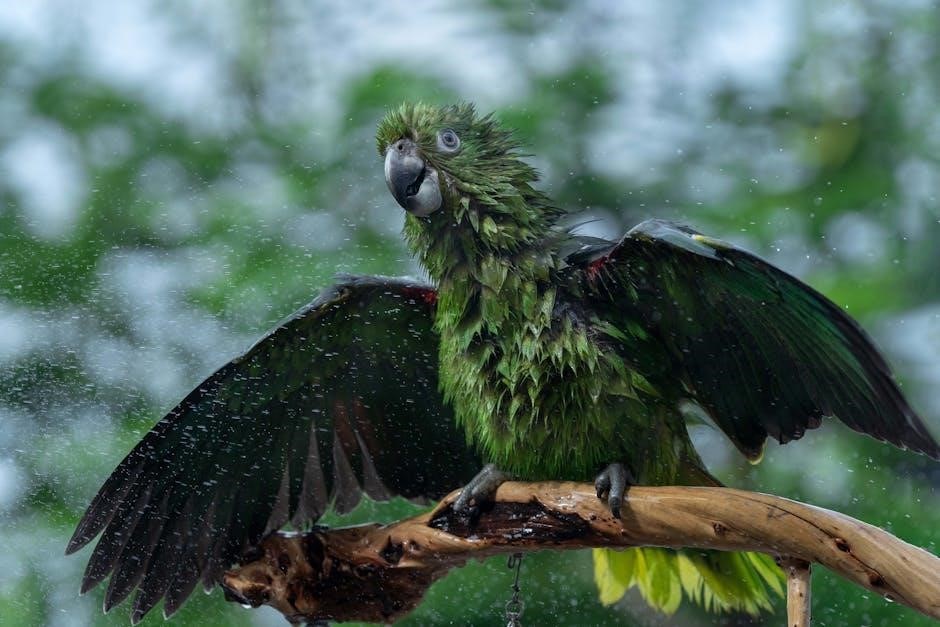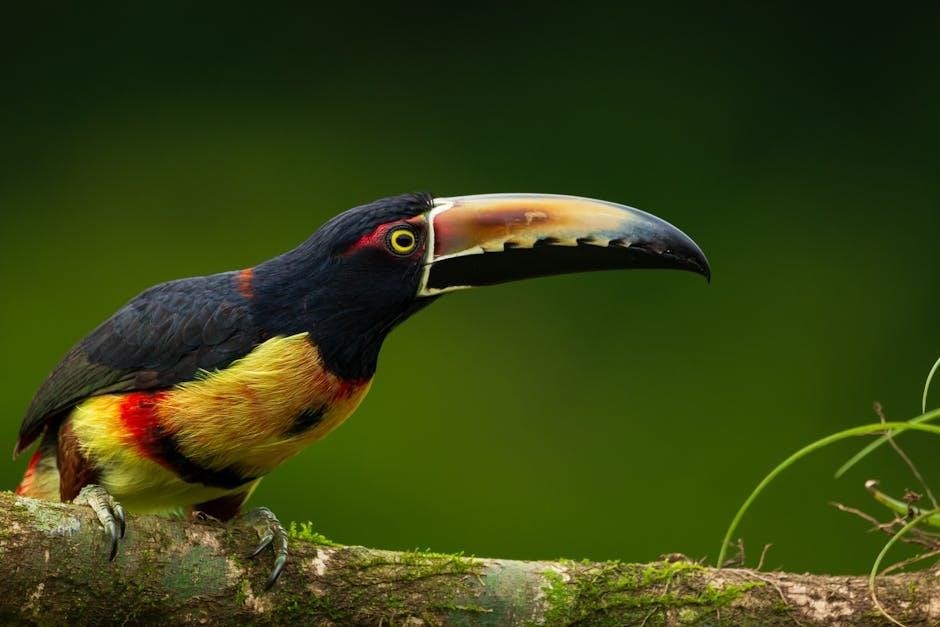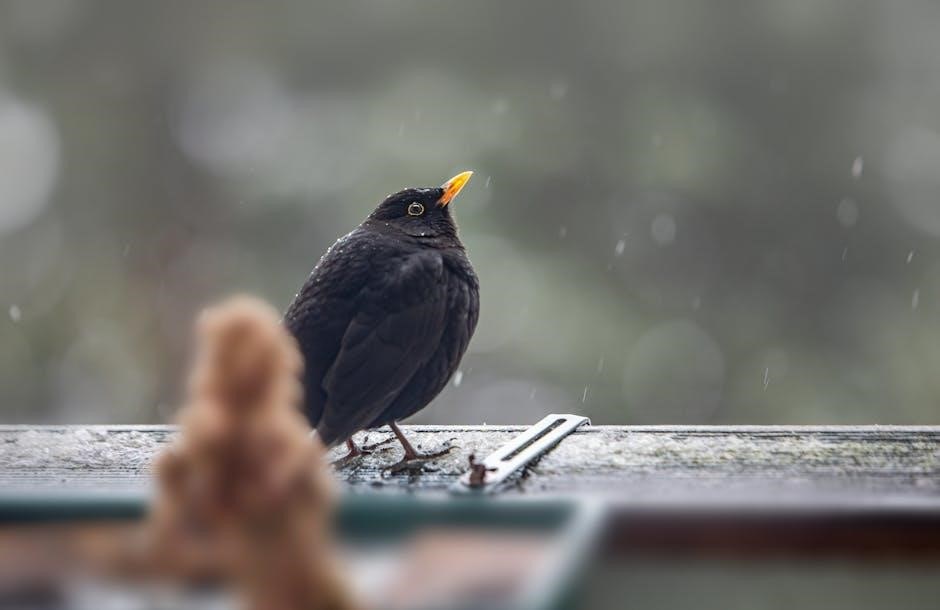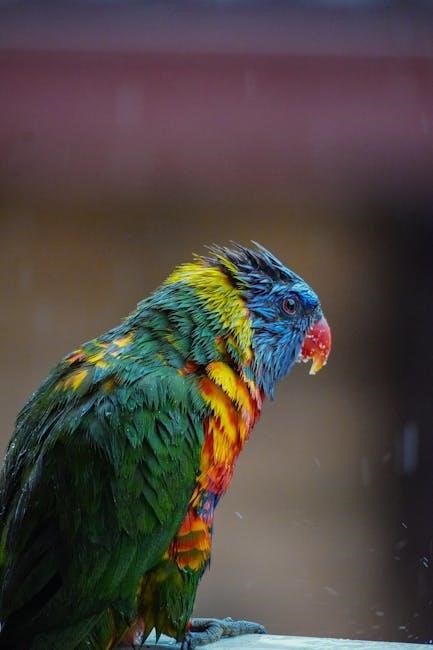Welcome to the Rain Bird Sprinkler Controller manual. This guide provides detailed instructions for installation, programming, and maintenance of your irrigation system, ensuring optimal performance and efficiency.
Overview of the Rain Bird Sprinkler Controller
The Rain Bird Sprinkler Controller is a versatile and user-friendly device designed to manage your irrigation system efficiently. It offers a range of features, including customizable watering schedules, zone control, and smart connectivity options. Available in various models like the ESP-TM2 and SST1200OUT, it caters to both residential and commercial needs. The controller ensures precise water distribution, reducing waste and promoting healthy plant growth. With a focus on durability and ease of use, Rain Bird controllers are a popular choice for modern irrigation systems, providing reliable performance season after season.
Importance of Proper Programming and Maintenance
Proper programming and maintenance of your Rain Bird Sprinkler Controller are crucial for ensuring efficient water use and system longevity. Incorrect settings can lead to overwatering, underwatering, or uneven coverage, potentially damaging your lawn and plants. Regular maintenance, such as cleaning the controller and checking wire connections, prevents malfunctions and ensures consistent performance. By following the guidelines in this manual, you can optimize your irrigation system, reduce water waste, and extend the lifespan of your Rain Bird controller.
Quick Reference Guide for Common Tasks
For quick access to essential functions, refer to the following guide:
– Programming: Set the date/time, access program mode, select zones, and adjust start times and durations.
– Manual Operation: Turn zones on/off manually for testing or extra watering.
– Troubleshooting: Check wire connections, ensure valves are functioning, and reset the controller if necessary.
– Maintenance: Regularly clean the controller and inspect wires for damage.
This guide helps you perform common tasks efficiently, ensuring your system runs smoothly year-round.

Installation
Mount the controller indoors, wire zones to valves, connect the power supply, and complete initial setup. Refer to the manual for detailed installation instructions and safety tips.
Mounting the Controller
Mount the Rain Bird controller indoors in a dry, protected location, such as a garage or utility room. Ensure it is accessible for programming and maintenance. Use the provided mounting screws to secure the controller to a wall or flat surface. Make sure the controller is level and firmly attached. Avoid exposing it to direct sunlight or moisture. Place it near the sprinkler system for convenient wiring access. Follow the manual’s installation guide for proper placement and alignment to ensure optimal performance and ease of use.
Wiring the Zones
Wiring the zones is a critical step in setting up your Rain Bird sprinkler controller. Begin by connecting each zone wire to the corresponding terminal on the controller. Use a wire stripper to expose the conductors and ensure secure connections. Avoid short circuits by keeping wires properly insulated. Connect the common wire to the “COM” terminal and each zone wire to its designated terminal. Use waterproof connectors for outdoor wiring to prevent damage. Label each wire for easy identification. Test each zone after wiring to ensure proper operation and connectivity.
Connecting the Power Supply
Connect the Rain Bird controller to a reliable power source. Plug the controller into a nearby GFCI-protected outlet using the provided power cord. Ensure the outlet matches the controller’s voltage requirements, typically 120V or 240V, depending on the model. If using a pump, verify the pump’s voltage compatibility with the controller. Avoid using extension cords to maintain consistent power supply. If the controller has a fuse, check for blown fuses and replace them as needed. Ensure all connections are secure to prevent power interruptions. After connecting, test the controller to confirm proper operation.
Initial Setup and Configuration
Power on your Rain Bird controller and set the current date and time. Navigate to the program menu to select and configure each zone. Choose the watering schedule, start times, and frequencies for optimal irrigation. Assign specific run times for each zone based on soil type and plant needs. Save all settings to ensure proper operation. Test the system by manually running each zone to verify functionality. This initial setup ensures your irrigation system operates efficiently, tailored to your lawn’s specific requirements.
Programming the Controller
Access program mode to set start times, durations, and frequencies for each zone. Adjust settings based on soil type and plant needs, then save and test configurations.
Setting the Date and Time
To ensure accurate watering schedules, set the current date and time on your Rain Bird controller. Access the main menu, navigate to the “Date and Time” section, and adjust the values using the arrow keys. Save your changes to synchronize the controller’s clock with your irrigation schedule. For Wi-Fi-enabled models, the Rain Bird app can also be used to remotely update the date and time, ensuring seamless operation. Always verify the time zone and format (MM/DD/YYYY) for proper functionality. A correct setup guarantees precise irrigation cycles.
Configuring Watering Schedules
Configuring watering schedules on your Rain Bird controller involves setting start times, durations, and frequencies for each zone. Access the “Watering Schedules” menu, select the desired program (A, B, or C), and choose the zones you want to configure. Set the start time using the arrow keys, then adjust the watering duration and frequency (daily, every other day, etc.). Customization allows tailored watering for different zones based on plant needs. Save your settings to ensure the schedule runs automatically. Use the Rain Bird app for remote adjustments and optimal water management. Always verify schedules align with local watering restrictions for efficiency.
Adjusting Run Times for Each Zone
To adjust run times for each zone, navigate to the “Zone Settings” menu on your Rain Bird controller. Select the specific zone you wish to modify using the arrow keys. Use the “+” or “-” buttons to increase or decrease the run time in minutes. Ensure the run time aligns with the water needs of the plants in that zone. After setting the desired duration, press “Save” to confirm the changes. This customization ensures each zone receives the right amount of water, optimizing efficiency and plant health. Regular adjustments may be needed based on seasonal changes or weather conditions.

Setting Start Times and Watering Frequencies
To set start times and watering frequencies on your Rain Bird controller, navigate to the “Watering Schedule” menu. Select the desired program (A, B, or C) and choose the zone or stations you wish to configure. Use the arrow keys to set the start time in hours and minutes. Next, select the watering frequency (e.g., daily, every other day, or specific days of the week). Confirm your settings by pressing “Save.” For added convenience, you can also adjust these settings via the Rain Bird app. This feature ensures your lawn receives consistent watering while saving water. Regularly review and update these settings to adapt to weather changes or seasonal needs.

Troubleshooting
Identify issues like non-working zones or display malfunctions. Check wires, power supply, and controller settings. Use the Rain Bird app for remote diagnostics and solutions.
Identifying and Resolving Common Issues
Common issues with Rain Bird controllers include zones not activating, display malfunctions, or incorrect watering schedules. Start by checking the power supply and wiring connections. Ensure valves are functioning properly and solenoids are receiving power. If zones fail to activate, test manually by touching wires together. For display issues, reset the controller or check for firmware updates. Use the Rain Bird app for remote diagnostics and troubleshooting. Regular maintenance, like cleaning sensors and updating settings, can prevent many problems. Refer to the manual or online resources for detailed solutions and step-by-step guides.
Diagnosing Zone-Specific Problems

To diagnose zone-specific issues, start by identifying the non-functioning zone and checking its wiring connections to the controller. Ensure the solenoid is receiving power and functioning correctly. Manually test the zone by touching the two wires together to activate the valve. Use the Rain Bird app for remote diagnostics or check the controller’s display for error messages. Verify that watering schedules are correctly programmed for the affected zone. If issues persist, consult the manual or contact Rain Bird support for further assistance.
Troubleshooting the Controller Display
If the controller display is blank or unresponsive, first ensure the power supply is connected properly; Check for loose wires or blown fuses. Reset the controller by turning it off, waiting 30 seconds, and turning it back on. If the issue persists, verify that the display is not damaged. Consult the user manual for specific reset procedures or contact Rain Bird support for assistance. Ensure the controller is updated with the latest firmware to avoid display malfunctions.

Maintenance

Regular maintenance ensures optimal performance. Clean the controller, check connections, and perform seasonal checks. Winterization prevents damage, ensuring system longevity and reliable operation year-round.
Regular Checks for Optimal Performance
Regular maintenance is crucial for ensuring your Rain Bird sprinkler controller operates efficiently. Start by cleaning the controller and checking all wire connections to prevent corrosion or damage. Inspect the solenoid wires and valves for proper function, and ensure the water pressure is within the recommended range. Additionally, perform seasonal checks to verify zone operation and adjust run times as needed. Regularly updating the controller’s software and reviewing watering schedules will help maintain optimal performance and prevent issues before they arise.

Cleaning and Upkeep of the Controller
Regular cleaning and upkeep are essential to ensure your Rain Bird sprinkler controller functions smoothly. Use a soft, dry cloth to wipe down the controller’s exterior and remove any dust or debris. Avoid harsh chemicals, as they may damage the unit. Ensure the controller is protected from direct sunlight and extreme temperatures. Store it in a dry, secure location during off-seasons to prevent moisture buildup. Additionally, periodically inspect and clean the terminals and wiring to maintain proper connections and prevent corrosion.
Seasonal Preparation and Winterization
Proper seasonal preparation and winterization are crucial to protect your Rain Bird sprinkler controller from damage. Disconnect the power supply and drain the system to prevent freezing. Insulate outdoor components like valves and sensors to shield them from frost. Before winter, inspect for leaks and repair any damages. Set the controller to “rain mode” or disable watering schedules during the off-season. Store the controller in a dry, secure location to avoid moisture buildup. Label wires and components for easy reconnection in spring, ensuring a smooth restart of your irrigation system.

Smart Features and Connectivity
The Rain Bird controller offers advanced smart features, including WiFi connectivity and remote access via the Rain Bird app, enabling seamless control and monitoring from smart devices.
Using the Rain Bird App for Remote Control
The Rain Bird app allows you to control your sprinkler system remotely from your smartphone or tablet. Download the app, create an account, and connect your controller to WiFi. Once synced, you can adjust watering schedules, monitor system status, and manually start or stop zones. The app also provides real-time notifications for issues like low battery or faulty valves. With voice control integration, you can operate your sprinkler system hands-free. This feature ensures convenience and flexibility, making it easier to manage your irrigation system from anywhere. Regular app updates enhance functionality and security.
Enabling WiFi Connectivity
To enable WiFi connectivity on your Rain Bird sprinkler controller, navigate to the WiFi settings menu. Select your network from the available options and enter the password. Ensure the controller is in WiFi mode and within range of your router. Once connected, the controller will confirm the connection. For controllers without a built-in WiFi module, install the LNK WiFi Module and follow the pairing instructions. After successful setup, the controller will sync with the Rain Bird app, allowing remote access and control. This feature enhances convenience and accessibility for managing your irrigation system. Always ensure your WiFi network is secure for optimal functionality.
Setting Up Remote Access
Setting up remote access for your Rain Bird sprinkler controller enhances convenience by allowing smartphone control. Begin by installing the LNK WiFi Module, ensuring compatibility with your controller model. Download the Rain Bird app, create or log into your account, and follow in-app instructions to connect your controller to your WiFi network. Enter your WiFi password carefully to establish a secure connection. After setup, test remote access through the app to control zones and schedules. Ensure your WiFi network is secure for added protection. If issues arise, consult the manual or seek support from Rain Bird resources.

Advanced Settings
Adjust watering restrictions, integrate rain sensors for automatic adjustments, and enable manual zone operation for precise control over your irrigation system’s performance and efficiency.
Adjusting Watering Restrictions
Adjusting watering restrictions on your Rain Bird controller allows you to customize water usage based on weather conditions and soil needs. Use the controller to set a watering budget, which adjusts run times proportionally. You can also enable restrictions like odd/even watering days or custom intervals. Additionally, integrate rain sensors to automatically pause irrigation during rainfall, ensuring water conservation without manual intervention. These advanced settings help optimize water usage while maintaining healthy landscaping.
Integrating Rain Sensors
Integrating a rain sensor with your Rain Bird controller enhances water conservation by automatically suspending irrigation during rainfall. To install, connect the sensor to the controller’s designated input terminal and mount it in an unobstructed outdoor location. The sensor detects moisture and signals the controller to pause watering. This feature ensures your system adapts to weather conditions, preventing overwatering and saving water. Refer to your controller’s manual for specific wiring instructions and compatibility details to ensure seamless integration and optimal performance.
Manual Operation of Zones
Manual operation allows you to control zones independently without altering the programmed schedule. To manually activate a zone, go to the controller and select the desired zone. Press and hold the manual start button until the zone begins watering. For immediate shutdown, press the off button. You can also use the Rain Bird app for remote manual operation. This feature is ideal for testing zones or providing extra water to specific areas. Ensure the controller is in manual mode to avoid conflicting with scheduled programs. This ensures precise control over your irrigation system when needed.
For further assistance, visit the Rain Bird Support Center for manuals, troubleshooting guides, and instructional videos. Additional resources are available on the Rain Bird website.
Final Checklist for Setup and Maintenance
- Ensure the date and time are correctly set on the controller.
- Verify all zones are properly connected and functioning.
- Test each zone manually to confirm operation.
- Review and adjust watering schedules as needed.
- Check the battery level and replace if necessary.
- Inspect wires and connections for damage or corrosion.
- Prepare the system for seasonal changes, such as winterization.
- Refer to the manual for troubleshooting common issues.
Where to Find Further Assistance and Manuals
For additional support, visit the official Rain Bird website, which offers detailed manuals, troubleshooting guides, and FAQs. The Rain Bird Support Center provides access to literature, videos, and model-specific resources. You can also download PDF manuals for your controller directly from their site. For further assistance, contact Rain Bird customer support or refer to the Connected Product Help section for remote access and configuration guidance. These resources ensure comprehensive support for your irrigation system needs.
